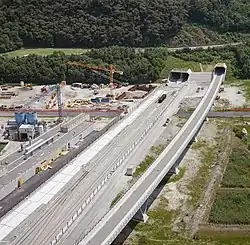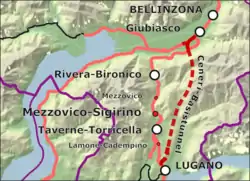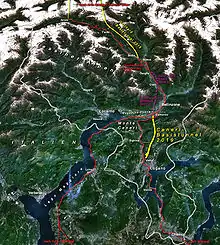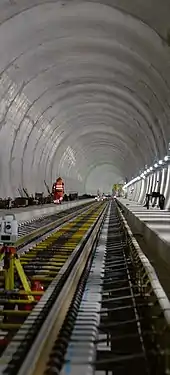 North portal in 2018 | |
| Overview | |
|---|---|
| Line | Gotthard Line |
| Location | Ticino, Switzerland |
| Coordinates | 46°07′09″N 8°59′27″E / 46.11917°N 8.99083°E |
| Status | Operational[1] |
| System | Swiss Federal Railways (SBB CFF FFS) |
| Crosses | Monte Ceneri |
| Start | Camorino in the Magadino Flat near Bellinzona, canton of Ticino |
| End | Vezia near Lugano, canton of Ticino |
| Operation | |
| Opened | 4 September 2020 |
| Owner | SBB Infrastructure |
| Operator | SBB CFF FFS |
| Traffic | Railway |
| Character | Passenger and freight |
| Technical | |
| Length | 15.4 km (9.6 mi)[2] |
| No. of tracks | 2 single-track tubes[2] |
| Track gauge | 1,435 mm (4 ft 8+1⁄2 in) (standard gauge) |
| Electrified | 15 kV 16.7 Hz |
| Operating speed |
|
| Route map | |
 | |
The Ceneri Base Tunnel (CBT, Italian: Galleria di base del Monte Ceneri) is a Swiss railway base tunnel in the canton of Ticino. It passes under Monte Ceneri between Camorino in the Magadino Flat and Vezia near Lugano; it bypasses the former high-altitude rail route through the Monte Ceneri Tunnel. It is composed of two single-track tunnels, each 15.4 km (9.6 mi) long.[4] It is part of the New Railway Link through the Alps (NRLA) project for faster north-south rail links across the Swiss Alps.
An exploration tunnel near Sigirino was excavated between 1999 and 2003 to gain geological data on the rock formations at the Ceneri Base Tunnel's level. Based on those data, it was decided to excavate most of the tunnel with traditional blasting methods and only drill a small part using a faster tunnel boring machine (TBM). Both the CBT and Gotthard Base Tunnels were built under contract from the Swiss Federal Government by Alptransit Gotthard AG. Construction of the two single-track bores started during March 2006. The official start of the CBT's construction phase was celebrated on 2 June 2006 with the laying of a foundation stone. The final breakthroughs took place on 21 January 2016 (west tube) and 26 January 2016 (east tube). Rail service started on 4 September 2020 and was operationalised for freight in December 2020.[5][6]
On opening, the Ceneri Base Tunnel has become an important southern feeder for the Gotthard Base Tunnel as the existing, proportionally steep and curvy track over Monte Ceneri is not suitable for high speeds or heavy freight trains. Another feeder is the Luino link along Lake Maggiore which is about to be upgraded by Italy in prospect of the opening of the Gotthard Base Tunnel. Both links meet in the Magadino Flat in the future Camorino Node (Italian: Nodo di Camorino). The CBT will ease local train traffic, mainly between the two major cities Locarno and Lugano but also between Bellinzona and Lugano. Travel time on the TILO, an S-Bahn, from Locarno to Lugano dropped from 50 to 22 minutes.
History
Background

The Ceneri Base Tunnel is the lowest of the routes through the Ceneri axis and connects Camorino in the Magadino Flat to Vezia near Lugano. It allows traffic to bypass the conventional high-level railway running through the historic Monte Ceneri Tunnel.[7] It forms only one element of a wider effort, commonly referred to as the New Rail Link through the Alps (NRLA) programme, which is being developed by AlpTransit Gotthard AG (ATG), a wholly owned subsidiary of the Swiss Federal Railways (SBB). When it became operational in December 2020, the Ceneri Base Tunnel began working together with the longer Gotthard Base Tunnel to significantly shorten the journey times between the Northern Swiss city of Zurich and the Northern Italian city of Milan by providing a flatter route for freight and passenger trains than previous conventional lines.[7][8]
The Ceneri Base Tunnel carries a pair of parallel bores, each containing a single-track, set 40 metres (130 ft) apart from one another and connected by cross passages at evenly spaced intervals of 325 metres (1,066 ft).[7] Stretching between the towns of Camorino and Vezia, it possesses a total length of 39.78 kilometres (24.72 mi); the eastern bore has a length of 15.45 kilometres (9.60 mi) and the west bore is 15.28 kilometres (9.49 mi) long. An operations center controlling ventilation and logistical activities has been constructed at Sigirino.[7] Operationally, the Ceneri Base Tunnel is anticipated to be used by in excess of 300 trains each day travelling in both directions. It shall be furnished with ETCS Level 2 signalling, allowing for trains to traverse it at speeds of up to 250 kilometres per hour (160 mph).[9] Although the technical maximum speed is 250 km/h (160 mph) through the Ceneri tunnel, the maximal authorized speed has been reduced to 230 km/h (140 mph) for ecological and economical reasons, while the operating speed of passenger trains is restricted to 200 km/h (124 mph) in order to accommodate the freight traffic, with the possibility to accelerate up to 230 km/h in case of delay.[3]
For handling emergency situations in the Ceneri Base Tunnel, the Swiss Federal Railways has acquired a fleet of dedicated rescue trains; these are equipped with specialised fire fighting equipment and other useful facilities, such as independent air supplies.[10]
The Ceneri Base Tunnel was approved in July 2001 by the Swiss Federal Council, clearing the way for detailing planning activity to proceed.[7] Further Parliamentary approval of the selected route for the tunnel was received in 2003, and the first funds towards construction were released during 2005.[11] During April 2007, AlpTransit Gotthard AG awarded a Sfr85m ($91.52m) contract for the construction of the first underground element of the tunnel to Consorzio Monte Ceneri (CMC) JV, a consortium of CSC, Lugano, Frutiger, Thun, Rothpletz, Lienhard & Cie, and Aarau.[7] During June 2009, the Board of Directors of AlpTransit Gotthard AG announced that it had awarded the principal contract for the tunnel's construction to the Consorzio Condotte Cossi consortium. At the time, the tunnel was expected to be operational by December 2020.[12] This contract was valued at Sfr987 million ($1.6 billion). The estimated total cost for the Ceneri Base Tunnel is Sfr2.4 billion ($2.58 billion).[7]
Construction

During June 2006, construction work on the tunnel officially commenced.[7] In November 2008, the excavation of a 2.4-kilometre-long (1.5 mi) adit tunnel was completed, involving the excavation of 160,000 cubic metres (5.7 million cubic feet) of hard rock. A tunnel boring machine (TBM), provided by Robbins Company and equipped with 483-millimetre (19.0 in) cutters, was used to bore the adit tunnel over the course of ten months during which it advanced at a rate of 18.5 metres (61 ft) per day.[13][7] During the spring of 2010, work commenced upon the boring of the Ceneri Base Tunnel itself. During March 2010, it was announced that blasting had begun on the main drives of the twin-bores.[14] By the end of the year, the rate of tunneling had reportedly attained its full speed. A combination of conventional drilling and blasting techniques were used to bore approximately 37.49 kilometres (23.30 mi) of the tunnel (including the two main tubes and access tunnels), while the remainder was bored using a TBM.[7]
Breakthrough in the west tube between Sigirino and Vezia occurred on 17 March 2015.[15][16] Breakthrough in the east tube between Sigirino and Vezia occurred on 30 March 2015. On 21 January 2016, breakthrough was achieved in the west bore between Sigirino and Vigana, while the breakthrough in the east bore between Sigirino and Vigana occurred on 26 January 2016.[7] That same day, it was announced that the excavation process had been completed, and the installation of railway infrastructure was the next major stage of the work.[7] During February 2017, the final concrete block was placed in a ceremony marking the tunnel becoming structurally complete.[17]
During August 2013, the Mons Ceneris Consortium, headed by Mancini & Marti, was awarded a Sfr96 million ($103.36 million) contract to provide railway track and logistics for the tunnel.[7] That same month, the Cablex-led CPC Consortium won a Sfr129 million ($138.89 million) contract to provide railway systems and overall tunnel co-ordination services. The planning, supply, installation and commissioning of the tunnel control systems, which are to be controlled from a control centre at Pollegio, has been contracted to Tunnel Control Systems.[7] The awarding of these contracts was not without controversy; a pair of appeals were subsequently upheld by the Federal Supreme Court of Switzerland regarding the awarding process. At one point, it looked as if the completion of the Ceneri Base Tunnel may be delayed as a consequence of legal disputes.[18][19] However, the dispute was settled during September 2014, which unblocked the awarding of contracts as well as allowing for work to proceed.[20]
During 2017 the installation of the track, electrical supply cables, telecommunications and radio systems, automation systems, overhead lines, and various safety and control systems commenced.[7] During August 2017, the first sections of ballastless track were laid in the northern end of the eastern bore.[21] On 30 May 2018, the final railroad tie was laid, meaning that trains can now travel the entire length of the tunnel.[22]
The tunnel was officially opened on 4 September 2020.[23][24][25][26][27] Final testing concluded with a rescue test in October 2020, and routine operations began in December 2020.[28][29][30][6] The construction has cost CHF 2.5bn.[31]
| Year | Month | Total excavated | ||
|---|---|---|---|---|
| km | mi | %[nb 1] | ||
| 2010 | 1 January | 7.600 | 4.72 | 18.9 |
| 1 February | 7.637 | 4.75 | 19.0 | |
| 1 March | 7.673 | 4.77 | 19.1 | |
| 1 April | 7.731 | 4.80 | 19.4 | |
| 1 May | 7.880 | 4.90 | 19.8 | |
| 1 June | 8.101 | 5.03 | 20.4 | |
| 1 July | 8.344 | 5.18 | 21.0 | |
| 1 August | 8.816 | 5.48 | 22.2 | |
| 1 September | 9.102 | 5.66 | 22.9 | |
| 1 October | 9.466 | 5.88 | 23.8 | |
| 1 November | 9.962 | 6.19 | 25.0 | |
| 1 December | 10.460 | 6.50 | 26.3 | |
| 2011 | 1 January | 10.820 | 6.72 | 27.2 |
| 1 February | 11.360 | 7.06 | 28.6 | |
| 1 March | 11.890 | 7.39 | 29.9 | |
| 1 April | 12.345 | 7.67 | 31.0 | |
| 1 May | 12.660 | 7.87 | 31.8 | |
| 1 June | 13.140 | 8.16 | 33.0 | |
| 1 July | 13.580 | 8.44 | 34.2 | |
| 1 August | 13.960 | 8.67 | 35.1 | |
| 1 September | 14.240 | 8.85 | 35.8 | |
| 1 October | 14.780 | 9.18 | 37.2 | |
| 1 November | 15.550 | 9.66 | 39.1 | |
| 1 December | 16.270 | 10.11 | 40.9 | |
| 2012 | 1 January | 16.800 | 10.44 | 42.4 |
| 1 February | 17.390 | 10.81 | 43.7 | |
| 1 March | 17.900 | 11.12 | 45.2 | |
| 1 April | 18.600 | 11.56 | 46.9 | |
| 1 May | 19.200 | 11.93 | 48.3 | |
| 1 June | 20.000 | 12.43 | 50.3 | |
| 1 July | 20.600 | 12.80 | 51.8 | |
| 1 August | 21.100 | 13.11 | 53.1 | |
| 1 September | 21.300 | 13.24 | 53.7 | |
| 1 October | 21.800 | 13.55 | 54.8 | |
| 1 November | 22.300 | 13.86 | 56.0 | |
| 1 December | 22.800 | 14.17 | 57.3 | |
| 2013 | 1 January | 23.000 | 14.29 | 57.9 |
| 1 February | 23.500 | 14.60 | 59.0 | |
| 1 March | 24.000 | 14.91 | 60.5 | |
| 1 April | 24.600 | 15.29 | 61.8 | |
| 1 May | 25.160 | 15.63 | 63.2 | |
| 1 June | 25.670 | 15.95 | 64.5 | |
| 1 July | 26.120 | 16.23 | 65.6 | |
| 1 August | 26.400 | 16.40 | 66.5 | |
| 1 September | 26.800 | 16.65 | 67.4 | |
| 1 October | 27.300 | 16.96 | 68.6 | |
| 1 November | 27.850 | 17.31 | 70.0 | |
| 1 December | 28.500 | 17.71 | 71.7 | |
| 2014 | 1 January | 28.500 | 17.71 | 71.7 |
| 1 February | 29.400 | 18.27 | 73.9 | |
| 1 March | 29.700 | 18.45 | 74.8 | |
| 1 April | 30.230 | 18.78 | 76.0 | |
| 1 May | 30.620 | 19.03 | 76.9 | |
| 1 June | 31.280 | 19.44 | 78.6 | |
| 1 July | 31.930 | 19.84 | 80.2 | |
| 1 August | 32.590 | 20.25 | 81.9 | |
| 1 September | 32.830 | 20.40 | 82.5 | |
| 1 October | 33.490 | 20.81 | 84.1 | |
| 1 November | 33.980 | 21.11 | 85.4 | |
| 1 December | 34.400 | 21.38 | 86.4 | |
| 2015 | 1 January | 34.750 | 21.59 | 87.3 |
| 1 February | 35.350 | 21.97 | 88.8 | |
| 1 March | 35.910 | 22.31 | 90.2 | |
| 1 April | 36.330 | 22.57 | 91.3 | |
| 1 May | 36.810 | 22.87 | 92.5 | |
| 1 June | 37.350 | 23.21 | 93.8 | |
| 1 July | 37.680 | 23.41 | 94.7 | |
| 1 August | 38.090 | 23.67 | 95.7 | |
| 1 September | 38.280 | 23.79 | 96.2 | |
| 1 October | 38.660 | 24.02 | 97.2 | |
| 1 November | 38.970 | 24.21 | 97.9 | |
| 1 December | 39.430 | 24.50 | 99.1 | |
| 2016 | 1 January | 39.670 | 24.65 | 99.7 |
| 1 February | 39.780 | 24.72 | 100 | |
Note:
| ||||
The monthly progress update graphic was available online.[32]
See also
References
- ↑ "Ceneri Base Tunnel Officially Open Completing the NRLA". 14 December 2020.
- 1 2 "Project data – raw construction Gotthard Base Tunnel" (PDF). Lucerne, Switzerland: AlpTransit Gotthard AG. 1 June 2016. Retrieved 15 December 2016.
- 1 2 Axe nord-sud du Saint-Gothard (SBB/CFF website).
- ↑ "Ceneri Base Tunnel". AlpTransit AG. Archived from the original on 28 November 2020. Retrieved 14 April 2016.
- ↑ "Sommaruga zur Eröffnung des Ceneri-Basistunnels: "Der Tunnel bringt die Schweiz näher zusammen" | NZZ".
- 1 2 "Ceneri Base Tunnel Officially Open Completing the NRLA". Railway-News. 14 December 2020. Retrieved 27 December 2020.
- 1 2 3 4 5 6 7 8 9 10 11 12 13 14 15 "Ceneri Base Tunnel." railway-technology.com, Retrieved: 10 June 2018.
- ↑ "SBB prepares for Gotthard base tunnel opening." Railway Gazette, 1 May 2015.
- ↑ "Thales awarded Ceneri Base Tunnel signalling contract." Railway Gazette, 16 September 2016.
- ↑ "SBB orders rescue trains." Railway Gazette, 7 February 2016.
- ↑ "Ceneri tunnel start." Railway Gazette, 1 August 2005.
- ↑ "Ceneri Base Tunnel: Blast-driving the main tunnel from Sigirino begins". AlpTransit Gotthard AG. 10 March 2009. Archived from the original on 15 April 2012. Retrieved 12 November 2011.
- ↑ "Ceneri Base Tunnel." therobbinscompany.com, Retrieved: 10 June 2018.
- ↑ "Ceneri base tunnel blasting begins ." Railway Gazette, 30 March 2010.
- ↑ "Ceneri Base Tunnel: Breakthrough in the west tube between Sigirino and Vezia: AlpTransit Gotthard AG". Archived from the original on 17 March 2015. Retrieved 17 March 2015.
- ↑ "First Ceneri base tunnel breakthrough." Railway Gazette, 18 March 2015.
- ↑ "Ceneri rail tunnel moves closer to completing new alpine rail link." thelocal.ch, 8 February 2017.
- ↑ "Ceneri Base Tunnel: two-year delay possible." Archived 12 June 2018 at the Wayback Machine tunnel-online.info, Retrieved: 10 June 2018.
- ↑ "Ceneri Base Tunnel: Swiss Supreme Court confirms Railway Infrastructure Awards." tunnel-online.info, June 2014.
- ↑ "Ceneri base tunnel dispute resolved." Railway Gazette, 14 September 2014.
- ↑ Barrow, Keith. "Tracklaying begins in Ceneri Base Tunnel." railjournal.com, 1 August 2017.
- ↑ "AlpTransit history" (PDF). Archived from the original (PDF) on 14 July 2019. Retrieved 14 July 2019.
- ↑ "Swiss complete trans-European rail route with Ceneri Tunnel under the Alps". Reuters. 4 September 2020 – via www.reuters.com.
- ↑ "Newly completed Swiss tunnel to transform European rail travel | DW | 04.09.2020". DW.COM.
- ↑ "Ceneri Base Tunnel inaugurated". Railway Gazette International.
- ↑ "Ceneri Base Tunnel is officially open". SWI swissinfo.ch.
- ↑ "Ceneri Base Tunnel inaugurated". 4 September 2020.
- ↑ "CBT: Switzerland's Third Largest Railway Tunnel Project | Blend Plants". Railway-News. 27 August 2020.
- ↑ "Ceneri Base Tunnel set for December opening". 8 August 2020.
- ↑ "Ceneri Base Tunnel: The First Tracks | Blend Plants". Railway-News. 27 August 2020.
- ↑ "Ceneri train tunnel starts final stage of testing before grand opening". worldradio.ch. 18 August 2020. Archived from the original on 18 August 2020. Retrieved 18 August 2020.
- ↑ "Archived copy". Archived from the original on 6 February 2016. Retrieved 5 February 2016.
{{cite web}}: CS1 maint: archived copy as title (link)